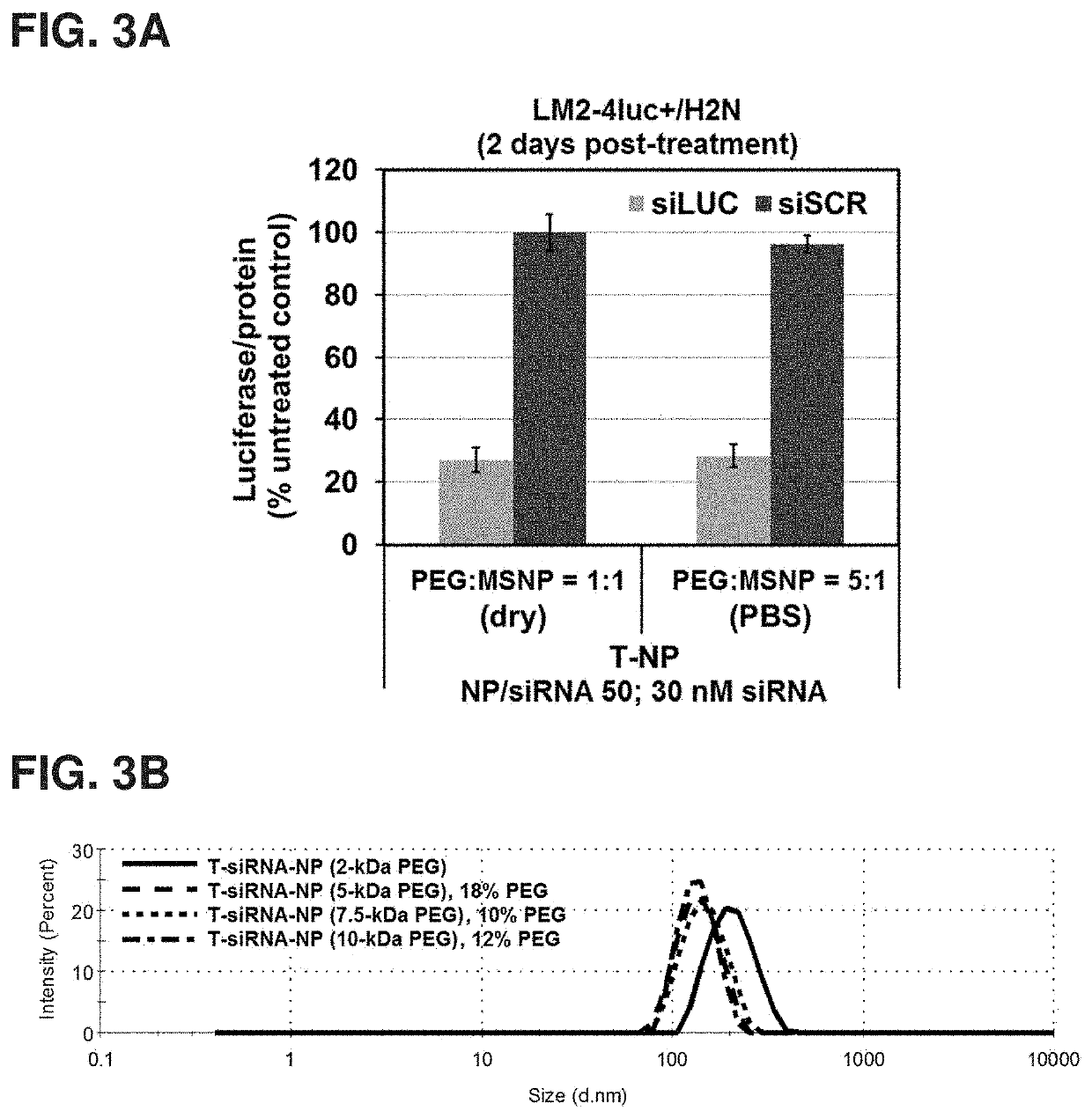Cross-linked polymer modified nanoparticles
a polymer and nanoparticle technology, applied in the field of cross-linked polymer modified nanoparticles, can solve the problems of short circulation half-life, difficult penetration of extracellular and intracellular barriers, and impeded the implementation of therapeutic modalities, so as to improve the rate of cancer cell death and improve the effect of cancer cell death
- Summary
- Abstract
- Description
- Claims
- Application Information
AI Technical Summary
Benefits of technology
Problems solved by technology
Method used
Image
Examples
example i
Synthesis of Uniform Nanoparticle Cores
[0173]The sol-gel synthesis of mesoporous silica nanoparticle cores (MSNPs) was modified from previous reports (L. Pan et al., 2012; I. Slowing et al., 2007). For 47-nm MSNPs, nanoparticle (NP) (S-47), 0.15 M cetyltrimethylammonium chloride (CTAC) and 350 μL of triethanolamine (TEA) were mixed in 125 mL of water at 95° C. Then, 3 mL of tetraethyl orthosilicate (TEOS) was added, and the mixture was stirred for one hour. All chemicals were purchased from Sigma Aldrich, USA.
[0174]After mixing, the pellets were recovered from suspension by centrifugation, washed with a copious amount of ethanol, and dried overnight. The particles were then resuspended and refluxed in acidic methanol (0.6 M HCl in methanol) overnight to remove CTAC and TEA. Bare MSNPs were then washed with ethanol and dried in a desiccator overnight. MSNP (dry) size was measured with TEM (Phillips / FEI CM120 / Biotwin TEM, Hillsboro, Oreg.) and hydrodynamic size with Zetasizer (ZS-90 / M...
example ii
Synthesis of Non-Uniform Nanoparticle Cores
[0176]Non-uniform MSNPs (O-87) were synthesized in the presence of a strong base. 6 mM cetyltrimethyl ammonium bromide (CTAB) was dissolved in 240 mL of aqueous solution of pH 11.0 (adjusted by 2 M NaOH). When the temperature stabilized at 80° C., 2.5 mL of TEOS was added, and the reaction continued for 2 hours. After mixing, the pellets were recovered from suspension by centrifugation, washed with a copious amount of ethanol, and dried overnight. The particles were then resuspended and refluxed in acidic methanol (0.6 M HCl in methanol) overnight to remove CTAB. Bare MSNPs were then washed with ethanol and dried in a desiccator overnight. MSNP (dry) size was measured with TEM (Phillips / FEI CM120 / Biotwin TEM, Hillsboro, Oreg.) and hydrodynamic size with Zetasizer (ZS-90 / Malvern, Malvern, U.K.). These non-uniform nanoparticle cores were 87±14 nm in size (see, e.g., FIG. 1A).
[0177]MSNPs prepared from Examples I and II were then coated layer-b...
example iii
Polyethylenimine (PEI) Attachment to MSNPs and Cross-Linking Methods
[0178]MSNPs prepared as described in Examples I and II were coated with PEI by shaking 10 mg MSNPs and 2.5 mg PEI in ethanol solution for 3 hours at room temperature. Next, the PEI-MSNP, was pelleted down. The material then underwent PEG attachment in Example IV or PEI cross-linking first prior to PEG attachment. For the PEI cross-linking method, the PEI-MSNP was re-suspended in ethanol solution containing 0 or 2.0 mg PEI (10 kDa) and 0.1-0.5 mg / ml DSP (DSP; dithiobis [succinimidyl propionate]; Lomant's Reagent) as a crosslinker. The solution was shaken for another 40 minutes. The particles were pelleted down, washed, and resuspended in PBS (pH 7.2). The hydrodynamic sizes of materials made under these various cross-linking conditions are shown in FIG. 2A, in which using 0.1 mg / ml DSP and 2 mg PEI during cross-linking yielded the most desirable size (similar to no cross-linker), while cross-linking alone without int...
PUM
| Property | Measurement | Unit |
|---|---|---|
| hydrodynamic size Z-average diameter | aaaaa | aaaaa |
| diameter | aaaaa | aaaaa |
| hydrodynamic size Z-average diameter | aaaaa | aaaaa |
Abstract
Description
Claims
Application Information
 Login to View More
Login to View More - R&D
- Intellectual Property
- Life Sciences
- Materials
- Tech Scout
- Unparalleled Data Quality
- Higher Quality Content
- 60% Fewer Hallucinations
Browse by: Latest US Patents, China's latest patents, Technical Efficacy Thesaurus, Application Domain, Technology Topic, Popular Technical Reports.
© 2025 PatSnap. All rights reserved.Legal|Privacy policy|Modern Slavery Act Transparency Statement|Sitemap|About US| Contact US: help@patsnap.com



